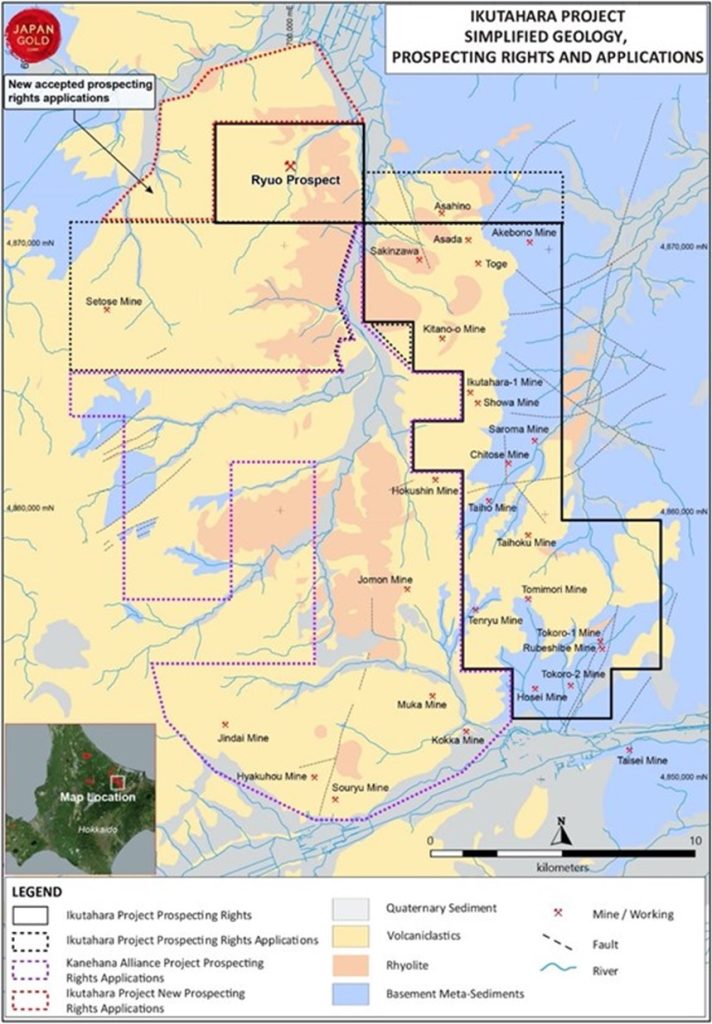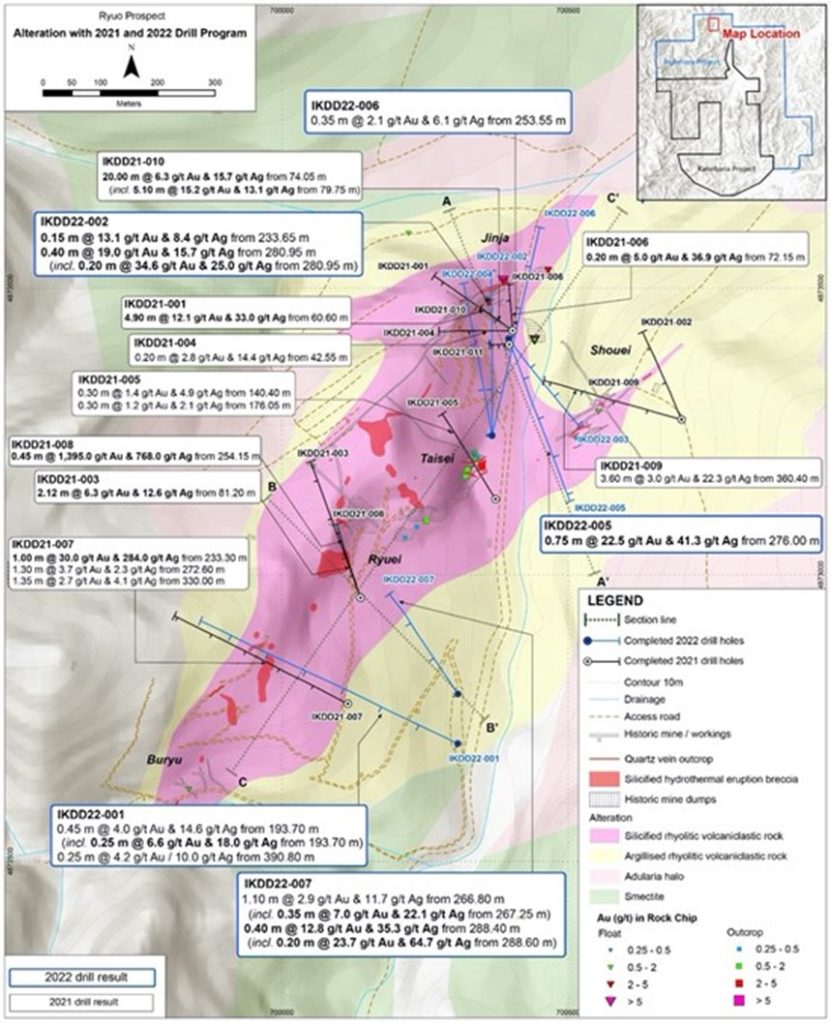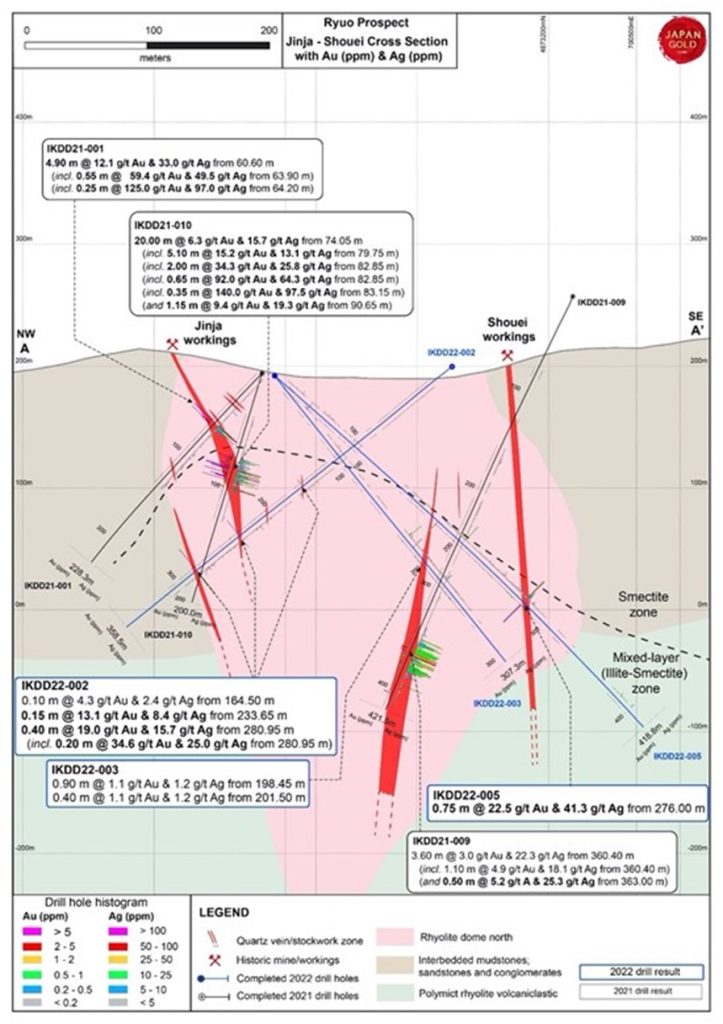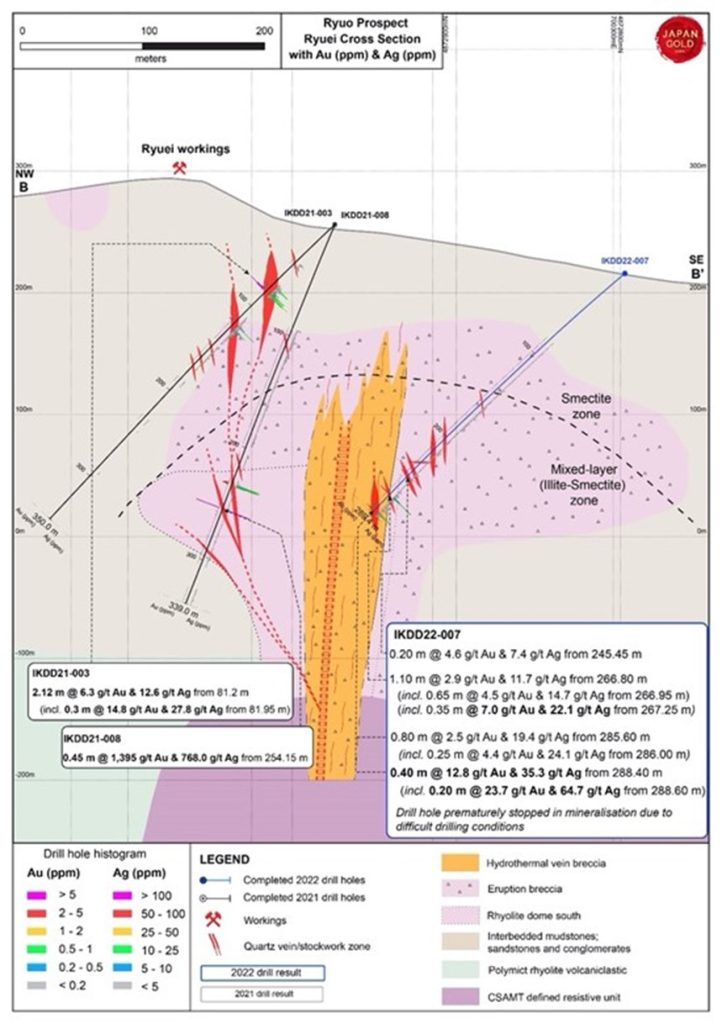
Japan Gold Continues to Drill High Grade Intercepts at Ryuo and Expands the Prospect Area

Japan Gold Corp. (TSX-V: JG) (OTCQB: JGLDF) is pleased to announce results from seven additional drill holes at the Ryuo Prospect. Drilling has continued to encounter high-grade veins along the Ryuo alteration corridor, and interpretation of drill core has significantly advanced the understanding of controls on mineralization at the prospect. The Ryuo prospect is located within the Company’s 100% owned Ikutahara Project in Hokkaido, (Figure 1).
Summary of High-Grade Intercepts, (Figures 2-5 and Table 1):
- IKDD22-005 has proven continuity of the Shouei vein 100 m to the southwest of the historical workings with the following high-grade zone from within a broader mineralized vein structure:
0.75 m @ 22.5 g/t Au & 41.3 g/t Ag from 276.0 m
- IKDD22-002: proved continuity of mineralization 50 m below the 2021 drill intercept from IKDD21-010 which intersected 20.0 m @ 6.3 g/t Au & 15.7 g/t Ag, giving the following significant interval:
0.4 m @ 19. 0 g/t Au & 15.7 Ag from 280.95 m
(Incl. 0.2 m @ 34.6 g/t Au & 25.0 g/t Ag from 280.95 m)
- IKDD22-007: targeted mineralization below IKDD21-008 which intersected the ultra-high-grade interval of 0.45 m @ 1,395 g/t Au & 768 g/t Ag. From approximately 200 m down hole IKDD22-007 encountered highly silicified and altered hydrothermally brecciated rhyolite cut by numerous banded quartz veins. The drill hole stopped in mineralization well short of its target depth under difficult drilling conditions and due to a temporary expiry of a local forestry permit, with the following significant intervals:
1.1m @ 2.9 g/t Au & 11.7 g/t Ag from 266.8 m
(incl. 0.35 m @ 7.0 g/t Au @ 22.1 g/t Ag from 267.25 m
0.4 m @ 12.8 g/t Au & 35.3 g/t Ag from 288.4 m
(incl. 0.2 m @ 23.7 g/t Au & 74.7 g/t Ag from 288.6 m)
Andrew Rowe, Vice President Exploration stated, “We are very encouraged by the recent findings at the Ryuo prospect. The combination of multiple high-grade vein structures with high-level vein textures and a well-preserved alteration system supports deeper drilling, particularly along strike to the southwest of the prospect. We look forward to completing another round of drill holes to test these concepts before the end of this year.”
Summary of Findings at Ryuo and the Implications for Ongoing Exploration:
The 2022 drill program has significantly advanced the understanding of geological controls and alteration zonation with respect to high-grade mineralization at Ryuo. Importantly, high-grade gold events have been identified along the length of the prospect in multiple parallel vein zones, and alteration studies prove the system is well preserved.
IKDD22-005 has proven an extension of the Shouei vein mineralization 100 m to the southwest. Further step out drilling is required to confirm strike continuity to depth below veining intersected in the top of drill hole IKDD21-005, and towards the open high-grade mineralization intersected 400 m to the southwest in drill holes IKDD21-008 and IKDD22-007, (Figure 2 & 3).
IKDD22-007 targeting the depth extension of the ultra high-grade vein in IKDD21-008 (0.45 m @ 1,395 g/t Au & 768 g/t Ag) terminated more than 100 m before target depth under difficult drilling conditions and due to a temporary expiry of a local forestry permit. From 200 m down-hole, intensely altered and hydrothermally brecciated rhyolite was drilled to the bottom of the hole at 289.4 m. Numerous banded quartz veins cut the brecciated rhyolite carrying anomalous gold along its length, with higher grade intervals including the 40 cm vein from the bottom of the hole which gave 12.8 g/t Au & 35.5 g/t Ag with a high-grade included interval of 23.7g/t Au & 64.7 g/t Ag (Figure 4). This breccia zone was unexpected and appears to be part of a significant, partially tested mineralized structure which subsequent drilling will target as a priority.
Hydrothermal alteration of the host rocks in low-sulphidation epithermal vein systems create a distinct zonal arrangement of clay minerals. Smectite dominant assemblages form above and peripheral to quartz veining, while a mixed-layer (illite-smectite) assemblage forms in the upper parts of the gold-bearing vein zone, this progresses downward into a chlorite-illite dominant assemblage which coincides with the boiling-zone where high-grade gold deposition occurs. This association of clay zonation and gold mineralization has been well documented in literature, including at the Hishikari mine in Kyushu2.
The upper part of this zonal arrangement of clay alteration has been interpreted from spectral analysis of drill core along the length of the Ryuo prospect. A smectite dominant zone is defined above and adjacent to higher grade veins, and a mixed-layer zone is interpreted from an illite+smectite dominant assemblage, associated with most of the high-grade veining seen to date, (Figures 3 & 4). The deeper chlorite-illite assemblage has not yet been recognized at Ryuo indicating the epithermal system is preserved and that the main high-grade boiling zone lies at depth. Additionally, the smectite / mixed-layer interface at Ryuo deepens or plunges to the southwest of the prospect. Similarly, the top of the rhyolite dome complex also lies deeper in the southwest of the alteration corridor, (Figure 4). Ongoing drilling will focus on targeting the deeper portions of the Ryuo hydrothermal system for high-grade mineralization associated with in the chlorite-illite zone.
Ryuo Prospect
The Ryuo Prospect consists of five areas of workings; Jinja, Shouei, Taisei, Ryuei and Buryu that were developed along a 1.2 km long, open ended trend of alteration and mineralization prior to the government-imposed closure in 1943 (Figure 2). Historical underground sampling in the Jinja vein workings revealed high-grade gold-silver mineralization including ‘level 4’ of the workings, which was sampled along a 72 m strike length giving an average grade of 40.8 g/t Au and 193 g/t Ag, with an average vein width approximately 0.5 m. Figure 3 illustrates a long-section of the Jinja vein workings with the underground sampling reported by the Metal Mining Agency of Japan (MMAJ)1.
New Accepted Prospecting Rights Applications at the Ikutahara Project
Eleven new prospecting rights were lodged to cover prospective Miocene volcanics immediately to the north and west of the Ryuo prospect to ensure coverage of potential strike and parallel extension to the Ryuo mineralization. The new applications comprising a total of 2,567 hectares have now been accepted by the Ministry of Economy Trade and Industry (METI) Hokkaido, (Figure 1).
Table 1: Significant Mineralized Intercepts for IKDD22-001 to IKDD22-007
| Drill Hole Number | From (m) | To (m) | Length (m) | Au (g/t) | Ag (g/t) |
| IKDD22-001 | 161.35 | 161.50 | 0.15 | 2.6 | 22.3 |
| 193.70 | 194.15 | 0.45 | 4.0 | 14.6 | |
| incl. | 193.70 | 193.95 | 0.25 | 6.6 | 18.0 |
| 360.80 | 361.15 | 0.35 | 1.2 | 1.3 | |
| 390.00 | 390.25 | 0.25 | 4.2 | 10.0 | |
| IKDD22-002 | 164.50 | 164.60 | 0.10 | 4.3 | 2.4 |
| 233.65 | 233.80 | 0.15 | 13.1 | 8.4 | |
| 280.95 | 281.35 | 0.40 | 19.0 | 15.7 | |
| incl. | 280.95 | 281.15 | 0.20 | 34.6 | 25.0 |
| IKDD22-003 | 198.45 | 199.35 | 0.90 | 1.1 | 1.2 |
| IKDD22-004 | No Significant Intersections | ||||
| IKDD22-005 | 276.00 | 276.75 | 0.75 | 22.50 | 41.30 |
| IKDD22-006 | 253.55 | 253.90 | 0.35 | 2.10 | 6.10 |
| 309.20 | 309.40 | 0.20 | 1.50 | 1.40 | |
| IKDD22-007 | 245.45 | 245.65 | 0.20 | 4.60 | 7.40 |
| 266.80 | 267.90 | 1.10 | 2.90 | 11.70 | |
| incl. | 266.95 | 267.60 | 0.65 | 4.50 | 14.70 |
| incl. | 267.25 | 267.60 | 0.35 | 7.00 | 22.10 |
| 285.60 | 286.40 | 0.80 | 2.50 | 19.40 | |
| incl. | 286.00 | 286.25 | 0.25 | 4.40 | 24.10 |
| 288.40 | 288.80 | 0.40 | 12.80 | 35.30 | |
| incl. | 288.60 | 288.80 | 0.20 | 23.70 | 64.70 |
Table 2: Ryuo Prospect Drill Hole Data
| Drill Hole Number | Location | Easting | Northing | RL | Azimuth | Dip | Length |
| IKDD22-001 | Buryu | 700306.89 | 4872705.56 | 214.00 | 295 | -40 | 683.00 |
| IKDD22-002 | Jinja | 700367.00 | 4873243.00 | 199.00 | 0 | -35 | 358.50 |
| IKDD22-003 | Shouei | 700396.00 | 4873412.00 | 192.00 | 143 | -50 | 307.30 |
| IKDD22-004 | Jinja | 700367.00 | 4873243.00 | 199.00 | 350 | -35 | 336.00 |
| IKDD22-005 | Taisei | 700396.00 | 4873412.00 | 192.00 | 160 | -41 | 418.80 |
| IKDD22-006 | Jinja | 700367.00 | 4873243.00 | 199.00 | 13 | -40 | 495.00 |
| IKDD22-007 | Ryuei | 700307.31 | 4872792.21 | 216.00 | 325 | -40 | 289.40 |
| TOTAL | 2,888.00 | ||||||
Reference
1 Metal Mining Agency of Japan, March 1990, Geological Survey Report for Fiscal Year 1989, Northern Hokkaido Area B-Metalliferous Deposits Overview.
2 Eiji Izawa et.al. 1990. The Hishikari Gold Deposit: high-grade epithermal veins in Quaternary volcanics of southern Kyushu Japan. Journal of Geochemical Exploration, 36 (1990) pp 1-56
Qualified Person
The technical information in this news release has been reviewed and approved by Japan Gold Vice President of Exploration and Country Manager, Andrew Rowe, BAppSc, FAusIMM, FSEG, who is a Qualified Person as defined by National Instrument 43-101.
About Japan Gold Corp.
Japan Gold Corp. is a Canadian mineral exploration company focused solely on gold exploration across the three largest islands of Japan: Hokkaido, Honshu and Kyushu. The Company has a country-wide alliance with Barrick Gold Corporation to jointly explore, develop and mine certain gold mineral properties and mining projects. The Company holds a portfolio of 31 gold projects which cover areas with known gold occurrences, a history of mining and are prospective for high-grade epithermal gold mineralization. Japan Gold’s leadership team represent decades of resource industry and business experience, and the Company has an operational team of geologists, drillers and technical advisors with experience exploring and operating in Japan.

Figure 1: Ikutahara Project, new and existing prospecting rights and applications on simplified geology with historical mines and workings.

Figure 2: Ryuo prospect, alteration map with historical workings and drill holes completed to date.

Figure 3: Ryuo Prospect, Jinja & Shouei veins cross section with geology, interpreted alteration and all significant drill intersections to date.

Figure 4: Ryuo prospect, Ryuei vein cross section with geology, interpreted alteration and all significant drill intersections to date.

Figure 5: Ryuo prospect long section with geology, interpreted alteration and drill hole pierce points and significant intersections.
MORE or "UNCATEGORIZED"
Visionary Copper and Gold Mines Inc. Closes Final Tranche of Private Placement Financing
Visionary Copper and Gold Mines Inc. (TSX-V: VCG) (OTCQX: VCGMF) ... READ MORE
PAN GLOBAL STEP-OUT DRILLING EXTENDS LA ROMANA DEPOSIT AT ESCACENA PROJECT, SOUTHERN SPAIN
Highlights include 1.26% copper, 0.01% tin, 2.3 g/t silver over 6... READ MORE
Sorbie Bornholm Announces New Investment of $6,000,000 in Homerun Resources
Sorbie Bornholm LP, a UK investment fund, is pleased to announce ... READ MORE
G2 Goldfields Delivers Maiden PEA for the High-Grade Oko Gold Project
PEA Highlights: High-grade updated resource: Underpinned by G2’... READ MORE
Titan Mining Closes US$15 Million Institutional Financing to Advance U.S. Graphite Strategy
Titan Mining Corporation (TSX:TI) (NYSE-A:TII), an existing zinc ... READ MORE












